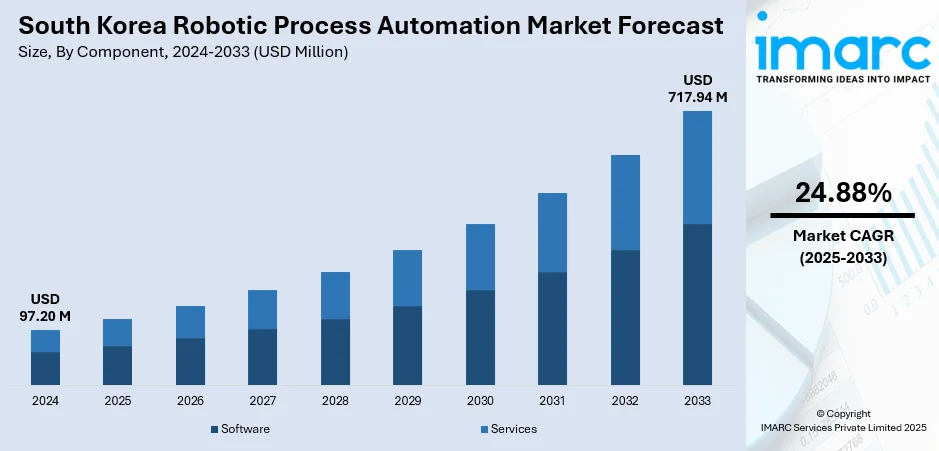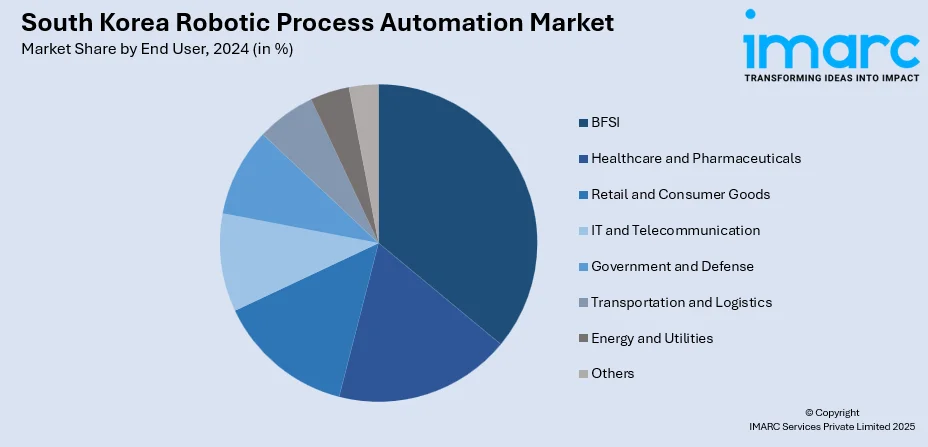
South Korea Robotic Process Automation Market Size, Share, Trends and Forecast by Component, Operation, Deployment Model, Organization Size, End User, and Region, 2025-2033
South Korea Robotic Process Automation Market Overview:
The South Korea robotic process automation market size reached USD 97.20 Million in 2024. Looking forward, the market is expected to reach USD 717.94 Million by 2033, exhibiting a growth rate (CAGR) of 24.88% during 2025-2033. The market in South Korea is expanding swiftly, driven by rising digital adoption, demand for workflow efficiency, and AI-powered solutions. Broad implementation across sectors such as finance, manufacturing, and IT, along with government backing, continues to shape the competitive dynamics of the South Korea robotic process automation market share.
|
Report Attribute
|
Key Statistics
|
|---|---|
|
Base Year
|
2024
|
|
Forecast Years
|
2025-2033
|
|
Historical Years
|
2019-2024
|
| Market Size in 2024 | USD 97.20 Million |
| Market Forecast in 2033 | USD 717.94 Million |
| Market Growth Rate 2025-2033 | 24.88% |
South Korea Robotic Process Automation Market Trends:
Accelerated Digital Transformation Across Industries
South Korea’s strong push for digital innovation across sectors is a primary driver of RPA adoption. Businesses are going all out to digitize operations to stay competitive, simplify processes, and improve productivity. In banking and finance, manufacturing, and healthcare, companies are implementing RPA to automate mundane, rule-based tasks and eliminate manual errors. The government's "Digital New Deal" initiative is also fuelling this trend by enabling the adoption of cutting-edge technologies, such as automation. Firms are using RPA to address the increasing need for real-time processing of data, automation of customer service, and business scalability. With digital maturity increasing across sectors, demand for scalable and intelligent RPA solutions will also increase tremendously, further cementing automation as a business strategic imperative.

To get more information on this market, Request Sample
Rising Labor Costs and Workforce Efficiency Goals
South Korea faces increasing labor costs and a shrinking working-age population, prompting organizations to seek cost-effective alternatives to traditional workflows, which is driving the South Korea robotic process automation market growth. RPA offers an efficient solution by automating repetitive administrative and operational tasks, enabling companies to maintain productivity without significantly expanding their workforce. This technology enhances operational efficiency, accuracy, and speed, particularly valuable in sectors like banking, logistics, and customer service. With RPA bots working around the clock, businesses can improve turnaround times, reduce human errors, and allocate employees to higher-value tasks. The need to manage rising wage pressures while maintaining service quality is a key reason why enterprises in South Korea are rapidly turning to robotic process automation as a sustainable workforce augmentation strategy.
Strong Government Support and AI Integration
Government-backed initiatives and incentives have played a crucial role in accelerating RPA adoption in South Korea. Through policies under the “Korean Digital Strategy,” the government is actively promoting automation technologies, including RPA, to enhance national productivity and digital competitiveness. Support includes funding, tax benefits, and training programs aimed at encouraging both public and private sector entities to automate operations. Additionally, the integration of RPA with artificial intelligence (AI) is making automation smarter and more adaptive, enabling systems to handle complex processes such as natural language understanding and decision-making. This convergence of AI and RPA is fostering innovation in customer experience, fraud detection, and data analysis, making South Korea a leading market for intelligent automation solutions.
South Korea Robotic Process Automation Market Segmentation:
IMARC Group provides an analysis of the key trends in each segment of the market, along with forecasts at the country and regional levels for 2025-2033. Our report has categorized the market based on component, operation, deployment model, organization size, and end user.
Component Insights:
- Software
- Services
The report has provided a detailed breakup and analysis of the market based on component. This includes software and services.
Operation Insights:
- Rule-based
- Knowledge-based
A detailed breakup and analysis of the market based on the operation have also been provided in the report. This includes rule-based and knowledge-based.
Deployment Model Insights:
- On-premises
- Cloud-based
A detailed breakup and analysis of the market based on the deployment model have also been provided in the report. This includes on-premises and cloud-based.
Organization Size Insights:
- Large Enterprises
- Small and Medium-sized Enterprises
A detailed breakup and analysis of the market based on the organization size have also been provided in the report. This includes large enterprises and small and medium-sized enterprises.
End User Insights:

- BFSI
- Healthcare and Pharmaceuticals
- Retail and Consumer Goods
- IT and Telecommunication
- Government and Defense
- Transportation and Logistics
- Energy and Utilities
- Others
A detailed breakup and analysis of the market based on the end user have also been provided in the report. This includes BFSI, healthcare and pharmaceuticals, retail and consumer goods, IT and telecommunication, government and defense, transportation and logistics, energy and utilities, and others.
Regional Insights:
- Seoul Capital Area
- Yeongnam (Southeastern Region)
- Honam (Southwestern Region)
- Hoseo (Central Region)
- Others
The report has also provided a comprehensive analysis of all the major regional markets, which include Seoul Capital Area, Yeongnam (Southeastern Region), Honam (Southwestern Region), Hoseo (Central Region), and others.
Competitive Landscape:
The market research report has also provided a comprehensive analysis of the competitive landscape. Competitive analysis such as market structure, key player positioning, top winning strategies, competitive dashboard, and company evaluation quadrant has been covered in the report. Also, detailed profiles of all major companies have been provided.
South Korea Robotic Process Automation Market Report Coverage:
| Report Features | Details |
|---|---|
| Base Year of the Analysis | 2024 |
| Historical Period | 2019-2024 |
| Forecast Period | 2025-2033 |
| Units | Million USD |
| Scope of the Report |
Exploration of Historical Trends and Market Outlook, Industry Catalysts and Challenges, Segment-Wise Historical and Future Market Assessment:
|
| Components Covered | Software, Services |
| Operations Covered | Rule-based, Knowledge-based |
| Deployment Models Covered | On-premises, Cloud-based |
| Organization Sizes Covered | Large Enterprises, Small and Medium-Sized Enterprises |
| End Users Covered | BFSI, Healthcare and Pharmaceuticals, Retail and Consumer Goods, IT and Telecommunication, Government and Defense, Transportation and Logistics, Energy and Utilities, Others |
| Regions Covered | Seoul Capital Area, Yeongnam (Southeastern Region), Honam (Southwestern Region), Hoseo (Central Region), Others |
| Customization Scope | 10% Free Customization |
| Post-Sale Analyst Support | 10-12 Weeks |
| Delivery Format | PDF and Excel through Email (We can also provide the editable version of the report in PPT/Word format on special request) |
Key Questions Answered in This Report:
- How has the South Korea robotic process automation market performed so far and how will it perform in the coming years?
- What is the breakup of the South Korea robotic process automation market on the basis of component?
- What is the breakup of the South Korea robotic process automation market on the basis of operation?
- What is the breakup of the South Korea robotic process automation market on the basis of deployment model?
- What is the breakup of the South Korea robotic process automation market on the basis of organization size?
- What is the breakup of the South Korea robotic process automation market on the basis of end user?
- What is the breakup of the South Korea robotic process automation market on the basis of region?
- What are the various stages in the value chain of the South Korea robotic process automation market?
- What are the key driving factors and challenges in the South Korea robotic process automation market?
- What is the structure of the South Korea robotic process automation market and who are the key players?
- What is the degree of competition in the South Korea robotic process automation market?
Key Benefits for Stakeholders:
- IMARC’s industry report offers a comprehensive quantitative analysis of various market segments, historical and current market trends, market forecasts, and dynamics of the South Korea robotic process automation market from 2019-2033.
- The research report provides the latest information on the market drivers, challenges, and opportunities in the South Korea robotic process automation market.
- Porter's five forces analysis assist stakeholders in assessing the impact of new entrants, competitive rivalry, supplier power, buyer power, and the threat of substitution. It helps stakeholders to analyze the level of competition within the South Korea robotic process automation industry and its attractiveness.
- Competitive landscape allows stakeholders to understand their competitive environment and provides an insight into the current positions of key players in the market.
Need more help?
- Speak to our experienced analysts for insights on the current market scenarios.
- Include additional segments and countries to customize the report as per your requirement.
- Gain an unparalleled competitive advantage in your domain by understanding how to utilize the report and positively impacting your operations and revenue.
- For further assistance, please connect with our analysts.
 Request Customization
Request Customization
 Speak to an Analyst
Speak to an Analyst
 Request Brochure
Request Brochure
 Inquire Before Buying
Inquire Before Buying




.webp)




.webp)












